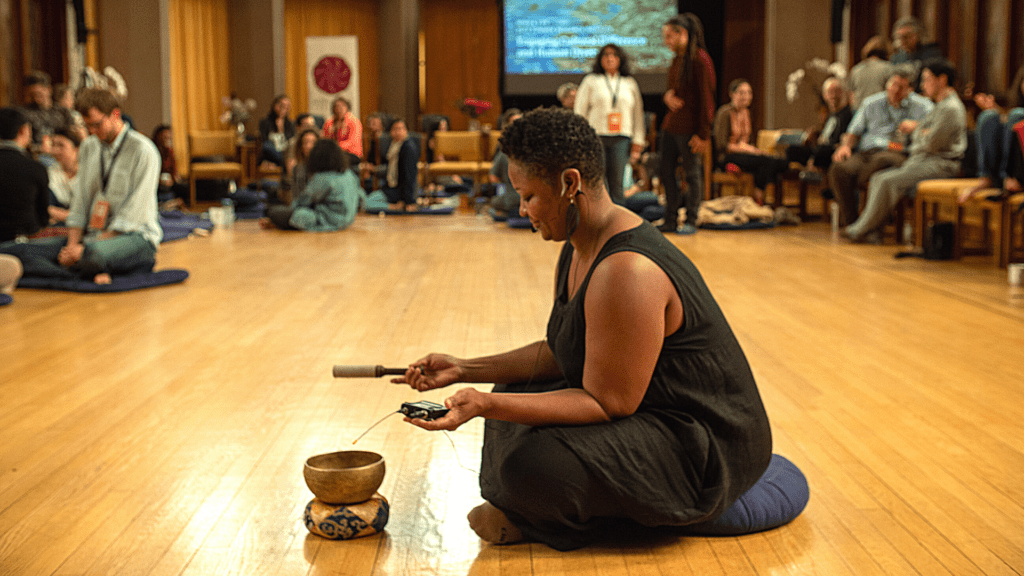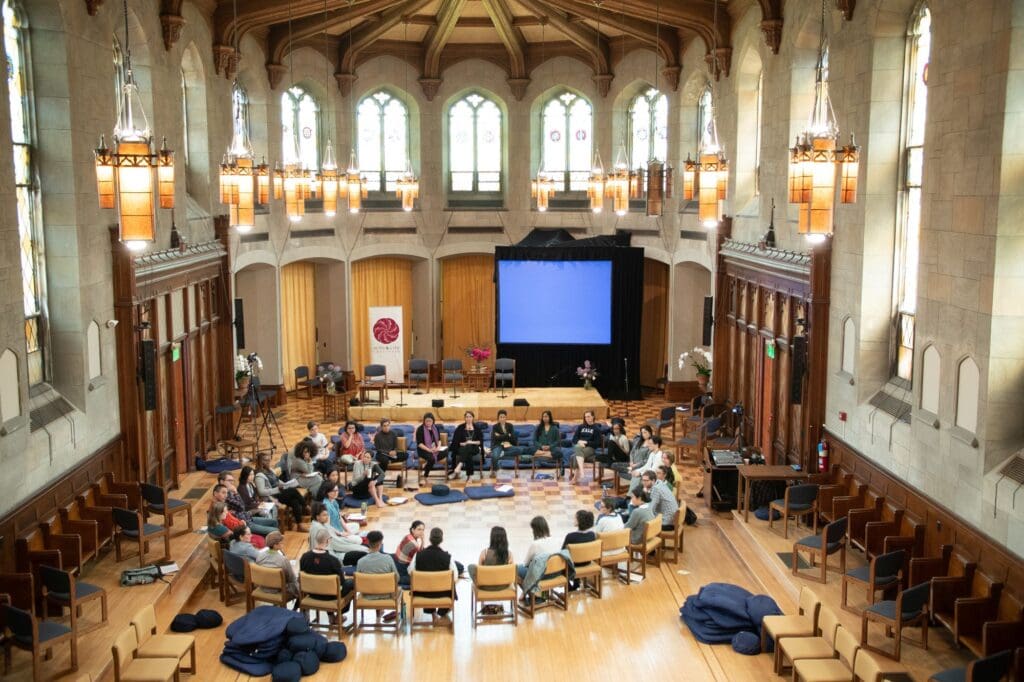Mind & Life periodically invites guest writers to contribute their perspectives and experiences to the blog as a way of deepening dialogue and understanding around key themes related to our mission.

In 2018, I found myself facing a new entanglement in my research. I had been researching and facilitating the use of dance to transform conflicts and nurture peace, and felt challenged to understand and engage with expressions of social injustice revealed through the moving body.
The topic of Mind and Life’s 2018 Summer Research Institute, “Engaging Cultural Difference and Human Diversity,” spoke to me and I applied. I arrived at the lush hills of the Garrison Institute that June seeking inspiration to better understand the dynamics of structural and cultural violence etched in bodies, emotions, and minds. I hoped to access resources to help me facilitate spaces for transformation through contemplative movement.
At the SRI, I learned practical applications for reflecting on biases and engaging difference, and the use of contemplative practices for nurturing compassion and redressing injustice. Furthermore, I encountered a multi-disciplinary learning community—a connected web of people gathered with the intention to transform and flourish.
While there is great enthusiasm for discovering new theories and techniques, the connective tissue of such gatherings is a thoughtful learning process that encourages curiosity, open exchange, and commitment to reflective action within and beyond the frontiers of that specific encounter. This learning community emphasizes embodiment, weaving first person experience with inquiry. The program intertwined meditation, yoga, qigong, lectures, and experiential break-out groups in a retreat-like setting. This allowed me to engage with the content more holistically, integrating it with my own ideas and experiences, and embodying them in a way that contributed not only to academic inquiry but personal transformation.
Contemplative practices such as dancing, meditation, and yoga can offer a container for cultivating awareness, presence, insight, and kindness. They invite a contemplative dive into one’s own depths, and in the process, help elicit resources for self-knowledge, healing, transformation, and flourishing. Learning communities seek to sustain a similar quality at an interpersonal level, facilitating the experience of circles of resonance.
Much like when ringing a singing bowl, each voice touches everyone else in the circle, and the reverberations caused by continuous dialogue create a resonance…
Trusting the knowledge available in each individual and elicited in the collective encounter, these circles offer a container in which diverse voices and experiences can be shared and heard. Much like when ringing a singing bowl, each voice touches everyone else in the circle, and the reverberations caused by continuous dialogue create a resonance that enables knowledge to deepen and expand1. Disagreement is welcome; constructive criticism is encouraged and practiced. Resonance implies harmony and dissonance, and sound is created by sustaining the tensions and engaging with paradoxes in freedom, from where pollination of perspectives may open space for new ways of relating. In reverberating each echo and the overall resonance of the circle, the learning community can elicit resources for dwelling in the messiness of life, relating fruitfully across difference and flourishing amidst uncertainty.
Being part of such a circle of resonance can also be challenging. They ask for openness to be affected by each other’s ideas, and courage to share one’s perspectives and critiques in an honest and compassionate way. It requires being present in the moment, attending to multiple sources of knowledge, communicating boundaries, and consent. It engages the body, senses, emotions, reason, and intuition, and asks for generously offering one’s own experiences and ideas in the often chaotic process of engendering knowledge.
The discussions on cultural difference and human diversity at the SRI equipped me to engage more auspiciously with embodied dynamics of structural and cultural violence elicited by contemplative movement. They also offered a reminder that witnessing the complexity of life pouring out of the web of relationships often cracks open spaces for celebrating interconnectedness and inspiring visions of a shared future. This was the spirit which animated the closing night, when the community gathered once again in a circle to dance, read poetry, sing, and inspire each other for action through performance.
Participating in the SRI renewed my commitment to inclusive and vulnerable research, refreshed my contemplative practice, and gave me tools to deepen my research and work with peace, conflict, dance, contemplative practices, and social justice. Furthermore, it evoked an awe for the joy of diversity and the richness of human flourishing in compassionate and engaged communion, which has been a source of inspiration during this particularly challenging year.
1. For more on the metaphor of the singing bowl in conflict transformation, see John Paul Lederach and Angela Jill Lederach’s When Blood and Bones Cry Out: Journeys Through the Soundscape of Healing and Reconciliation (Oxford University Press 2010).
Paula Ditzel Facci is a dancing peace researcher and facilitator, author of Dancing Conflicts, Unfolding Peaces: Movement as Method to Elicit Conflict Transformation (Palgrave 2020). She teaches at the Unit for Peace and Conflict Studies at the University of Innsbruck, and at the Instituto Paz e Mente, Brazil.


